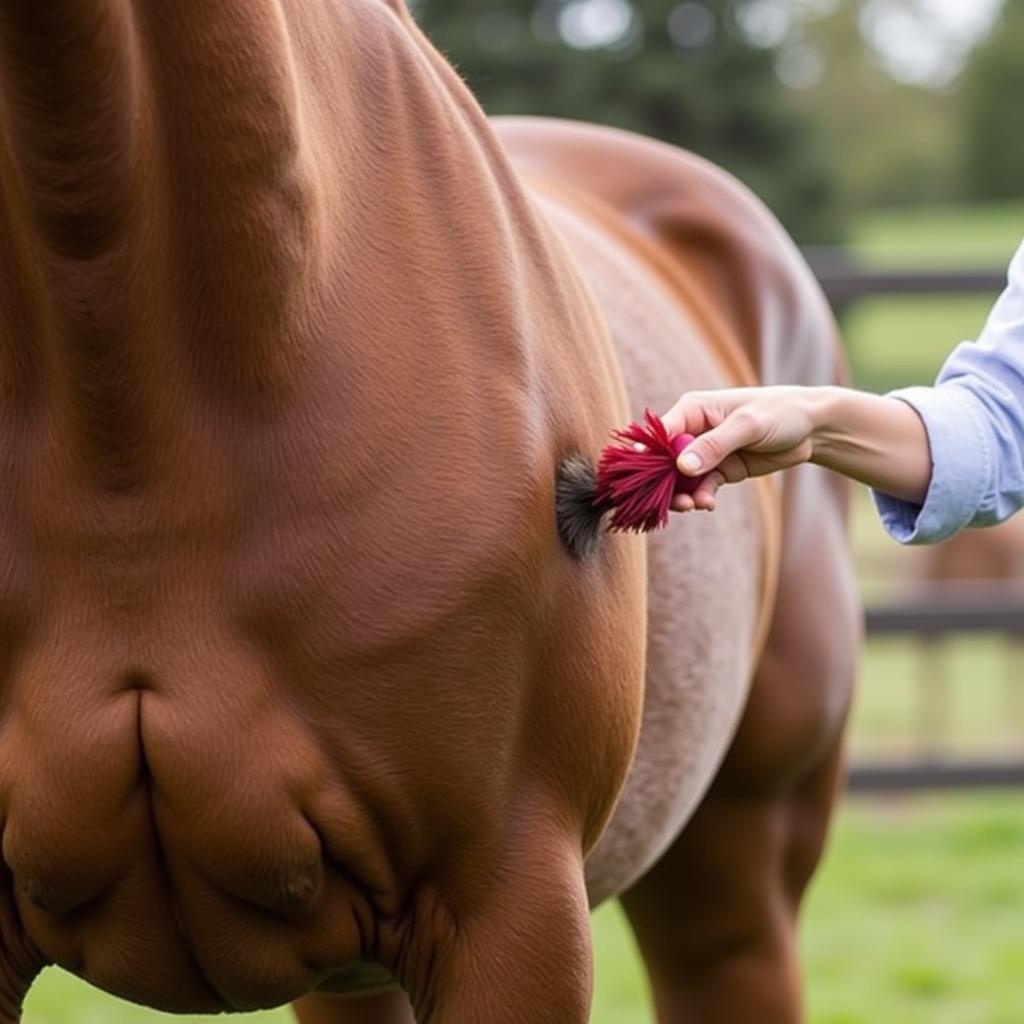The Horse Breast, a crucial area encompassing the chest and pectoral muscles, plays a significant role in a horse’s movement, power, and overall well-being. Understanding its anatomy, the tack designed for it, and proper care can significantly impact your horse’s performance and comfort.
Horse Breast Anatomy: A Closer Look
The horse’s breast consists of powerful pectoral muscles that attach to the humerus (upper arm bone) and the sternum (breastbone). These muscles are essential for locomotion, especially for pulling and turning. The sternum, a long flat bone, protects vital organs and provides attachment points for the ribs. This complex structure allows for the expansive chest movement necessary for respiration, especially during strenuous activity. A well-developed horse breast indicates strength and athleticism.
A strong, well-muscled breast is desirable in many disciplines, from driving to jumping. It provides the power and stability needed for collected movement and athletic performance. Understanding the underlying anatomy helps riders and owners appreciate the importance of proper conditioning and tack fit.
Choosing the Right Tack for the Horse Breast
Various tack options are available to interact with the horse breast, each designed for specific purposes. The most common are breastplates and breast collars. horse breastplate english are often used in English riding disciplines to prevent the saddle from slipping back, especially during jumping or cross-country. They distribute pressure across the chest and shoulders, ensuring stability and comfort. horse breasts play a critical role in ensuring proper tack fit and function.
Breast collars, on the other hand, are commonly used in driving and Western riding. They distribute the weight of the carriage or rider evenly across the chest, preventing choking and allowing for greater freedom of movement. horse tack breast collars provide crucial support for working horses. For those looking for added style, a horse breast collar with fringe can add a touch of Western flair. Regardless of your chosen tack, proper fit is paramount for both comfort and performance. A poorly fitted breastplate or breast collar can restrict movement, cause chafing, and even lead to injury.
Caring for the Horse Breast
Maintaining the health of the horse’s breast area involves regular grooming and inspection. Thorough brushing removes dirt and debris, promoting healthy skin and coat. Regularly checking for any signs of swelling, soreness, or injury is crucial. Early detection and treatment of any issues can prevent them from becoming more serious. Proper saddle and tack fit are paramount in preventing pressure sores and discomfort.
 Grooming a Horse's Breast
Grooming a Horse's Breast
“Regularly inspecting your horse’s breast area after exercise can help you identify potential problems early on,” advises Dr. Emily Carter, DVM, specializing in equine sports medicine. “Early intervention is key to preventing minor issues from developing into more serious conditions.”
Horse Breast: Frequently Asked Questions
What is the main function of the horse’s breast?
The horse’s breast primarily facilitates movement, especially pulling and turning. It also protects vital organs within the chest cavity.
How can I tell if my horse’s breastplate fits correctly?
A properly fitted breastplate should lie flat against the horse’s chest without pinching or restricting movement. It should be adjusted so that it does not interfere with the horse’s shoulder movement.
What are the different types of breast collars?
Common types include full breast collars, half breast collars, and breast straps, each designed for specific disciplines and purposes.
How can I prevent sores from a breast collar or breastplate?
Ensure proper fit, use padding if necessary, and regularly clean the tack and the horse’s breast area.
What are the signs of a sore breast in a horse?
Signs include swelling, heat, sensitivity to touch, and reluctance to move.
What should I do if I notice a sore on my horse’s breast?
Consult a veterinarian for diagnosis and treatment recommendations. Continuing to use ill-fitting tack can worsen the condition.
How can I strengthen my horse’s breast muscles?
Hill work, pulling exercises, and proper conditioning can help develop the pectoral muscles.
Conclusion
The horse breast is a vital area that requires attention and care. Understanding its anatomy, selecting appropriate tack like the horse breast plate, and implementing a consistent grooming routine are essential for maintaining the horse’s well-being and performance. By prioritizing these aspects, you can contribute to your horse’s long-term health and athletic success.
For support, contact us at Phone: 0772127271, Email: [email protected] or visit us at QGM2+WX2, Vị Trung, Vị Thuỷ, Hậu Giang, Vietnam. We have a 24/7 customer support team.